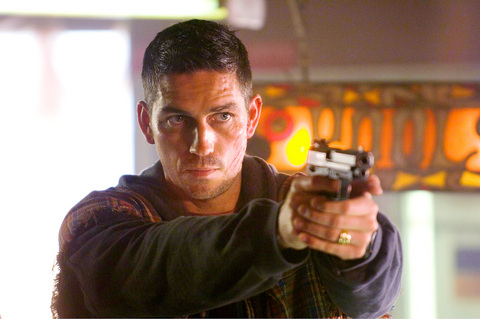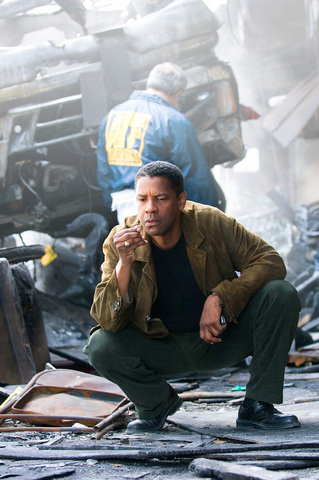In the cinema of big bangs, few bangs are bigger than those generated by the producer Jerry Bruckheimer. That's especially true when this influential hitmaker (his small-screen credits include the CSI franchise) teams up with the film director Tony Scott, with whom he has made six blockbusters, including the 1980s pop sensation Top Gun. Now comes Deja vu, an action flick with Denzel Washington in which the gaudy pyrotechnics are nowhere near as jaw-dropping as the screenplay that name-checks not one, not two, but three national tragedies against a backdrop of red blood, white uniforms and blue-sky improbability.
It doesn't take long before the filmmakers uncork their signature move and blow something up. In this case, that something is: the 543 men, women and children, including hundreds of sailors who, having gathered aboard an enormous New Orleans ferry, are blown to pieces almost as it pushes off. One minute a grandfatherly type in a veteran's cap is sitting with a small child in his lap; the next, a sailor is soaring through the air, his snowy white uniform cutting a stark picture against the fiery orange backdrop. At once awesome and absurd, the explosion doesn't just rip bodies discreetly apart but also shreds the film, because nothing else in Deja vu has been created with such loving attention to detail.
The dead have just started to be stacked up on the pier when Washington rolls up as Doug Carlin, an agent for the Bureau of Alcohol, Tobacco, Firearms and Explosives. Graced with almost uncanny powers of detection, Doug is the kind of investigator who sniffs the air, sifts the earth and all but walks on water to determine who did what, where, when and why. Standing on the banks of the Mississippi amid the carefully scattered wreckage, not a severed body part in view, he zeroes in on a speck of evidence that would have led straight to the killer if the credited screenwriters, Bill Marsilii and Terry Rossio, hadn't decided to kink up their terrorism plot with a beautiful dead woman and some nutty speculative fiction.

PHOTOS COURTESY OF BVI
Fantasists of a specific Hollywood kind, Bruckheimer and Scott rarely traffic in reality, even when they seem to want to. Deja vu is more removed from reality than most of their collaborations, which makes their exploitation of Sept. 11, Katrina and Oklahoma City (which earns a couple of vague mentions) less offensive than it might in a film that bore some relation to the real world. Yet Deja vu is so wildly divorced from the here and the now of contemporary politics, policy and people that it's impossible to get worked up by its invocation of these three calamities, though a throwaway shot of a decimated New Orleans neighborhood used purely for some atmospheric flavoring is certainly vulgar in the extreme.
Of course, vulgarity is part of the appeal of both a Jerry Bruckheimer film and a Tony Scott film, which exist purely for an evening's entertainment, for loud noises and flashy pictures, big stars and fast action, violence and yet more violence. Like all their partnerships, Deja vu has been calibrated for minimum thought and maximum diversion; too bad that, unlike Enemy of the State, by far the smartest and slickest of their joint efforts, this new film falls so perilously short. The joke of it is, for all the pricey bangs and booms, the whiplash cinematography and the editing that turns film space into cubistic tableaux, a Bruckheimer-and-Scott partnership is only as good as its screenplay, and this one is a mess.
It's also preposterous, even by the standards of the pulpiest speculative fiction. After Doug retrieves that crucial speck of evidence, which he delivers to the other shocked and awed law enforcement types working the case, he uncovers far more attractive evidence in the form of an apparent bomb victim, Claire (Paula Patton). For the unattached and all-but-friendless agent, the dead woman, who looks good even when stretched out on an autopsy table, becomes the key that unlocks the case and his heart. Like the detective in Otto Preminger's classic film noir Laura who falls for a woman he knows only through a portrait and other traces, Doug falls hard, though without the benefit of some memorable David Raksin theme music to cushion him.

In Laura, the detective solves the case with hard work and shoe leather. Doug tackles his job with hardware and hooey, which means he gets to the bottom of things — or, rather, hops a ride back into the past on the space-time continuum with some help from Val Kilmer (as a federal agent), Adam Goldberg (as a genius), a yellow Hummer and a room stuffed with blinking machines and flat screens that make the image we're watching look remarkably like a big computer monitor with several open software windows. To top it off, Jim Caviezel even shows up wearing the same military jacket that Robert De Niro wore in Taxi Driver and spouting religious-sounding verse, adding a delirious soupcon of Mel Gibson-style passion to a film that has long lost its way.

May 11 to May 18 The original Taichung Railway Station was long thought to have been completely razed. Opening on May 15, 1905, the one-story wooden structure soon outgrew its purpose and was replaced in 1917 by a grandiose, Western-style station. During construction on the third-generation station in 2017, workers discovered the service pit for the original station’s locomotive depot. A year later, a small wooden building on site was determined by historians to be the first stationmaster’s office, built around 1908. With these findings, the Taichung Railway Station Cultural Park now boasts that it has

The latest Formosa poll released at the end of last month shows confidence in President William Lai (賴清德) plunged 8.1 percent, while satisfaction with the Lai administration fared worse with a drop of 8.5 percent. Those lacking confidence in Lai jumped by 6 percent and dissatisfaction in his administration spiked up 6.7 percent. Confidence in Lai is still strong at 48.6 percent, compared to 43 percent lacking confidence — but this is his worst result overall since he took office. For the first time, dissatisfaction with his administration surpassed satisfaction, 47.3 to 47.1 percent. Though statistically a tie, for most

Wooden houses wedged between concrete, crumbling brick facades with roofs gaping to the sky, and tiled art deco buildings down narrow alleyways: Taichung Central District’s (中區) aging architecture reveals both the allure and reality of the old downtown. From Indigenous settlement to capital under Qing Dynasty rule through to Japanese colonization, Taichung’s Central District holds a long and layered history. The bygone beauty of its streets once earned it the nickname “Little Kyoto.” Since the late eighties, however, the shifting of economic and government centers westward signaled a gradual decline in the area’s evolving fortunes. With the regeneration of the once

In February of this year the Taipei Times reported on the visit of Lienchiang County Commissioner Wang Chung-ming (王忠銘) of the Chinese Nationalist Party (KMT) and a delegation to a lantern festival in Fuzhou’s Mawei District in Fujian Province. “Today, Mawei and Matsu jointly marked the lantern festival,” Wang was quoted as saying, adding that both sides “being of one people,” is a cause for joy. Wang was passing around a common claim of officials of the People’s Republic of China (PRC) and the PRC’s allies and supporters in Taiwan — KMT and the Taiwan People’s Party — and elsewhere: Taiwan and